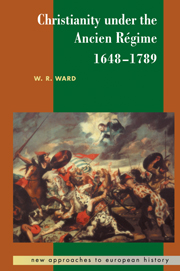Book contents
- Frontmatter
- Contents
- List of maps
- Preface
- Glossary
- 1 Peace and conflict: church and state in central and north-western Europe
- 2 Christianity in southern Europe
- 3 Catholicism in the Holy Roman Empire and the eastern Habsburg Lands
- 4 The religion of Protestants
- 5 Revival moves to the west
- 6 The Enlightenment and its precursors
- 7 The Churches in northern and eastern Europe
- 8 Religion after the Seven Years War
- Suggestions for further reading
- Index
- Title in the series
- Frontmatter
- Contents
- List of maps
- Preface
- Glossary
- 1 Peace and conflict: church and state in central and north-western Europe
- 2 Christianity in southern Europe
- 3 Catholicism in the Holy Roman Empire and the eastern Habsburg Lands
- 4 The religion of Protestants
- 5 Revival moves to the west
- 6 The Enlightenment and its precursors
- 7 The Churches in northern and eastern Europe
- 8 Religion after the Seven Years War
- Suggestions for further reading
- Index
- Title in the series
Summary
To outline the religious history even of Christianity alone among religions in Europe in the century and a half beween the Westphalia settlements and the French Revolution in a volume of modest compass, and to provide at the same time the basic introductions to the politics and the religious technicalities of the period which modern students need, involve a great exercise in leaving important things out and carry the risk of a somewhat importunate virtuosity in general judgments; the reader is entitled to know what the author thinks, though (within the limits of space) not always to the grounds on which opinions are based. It is well therefore to come clean at the outset as to strategy adopted. A history of Christianity in this period ought in my view to be primarily a history of religious belief and experience, and, while not neglecting the history of the churches, has less to do with a history of the churches than those bodies commonly claim. Thus a major institution like the papacy appears here as an engine of policy rather than as an institution; and the same is true of the principal feature of its institutional growth, Propaganda Fide. Religious belief and experience are, however, deeply affected by the churches' political involvement. It would be nice to feature an Alltagsge-schichte of popular religious observance and its significance, but for huge areas of Europe nothing of this kind is available; and where a good deal of work has been done its value has been diminished by the rashness of historians in adopting a rather amateur anthropology for the occasion.
- Type
- Chapter
- Information
- Christianity under the Ancien Régime, 1648–1789 , pp. ix - xPublisher: Cambridge University PressPrint publication year: 1999

